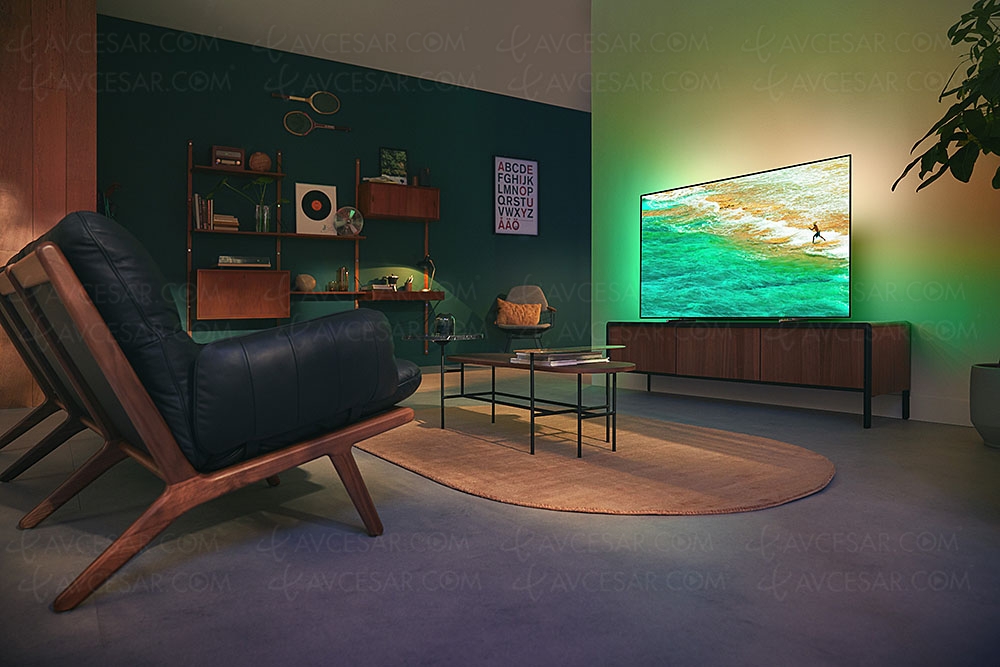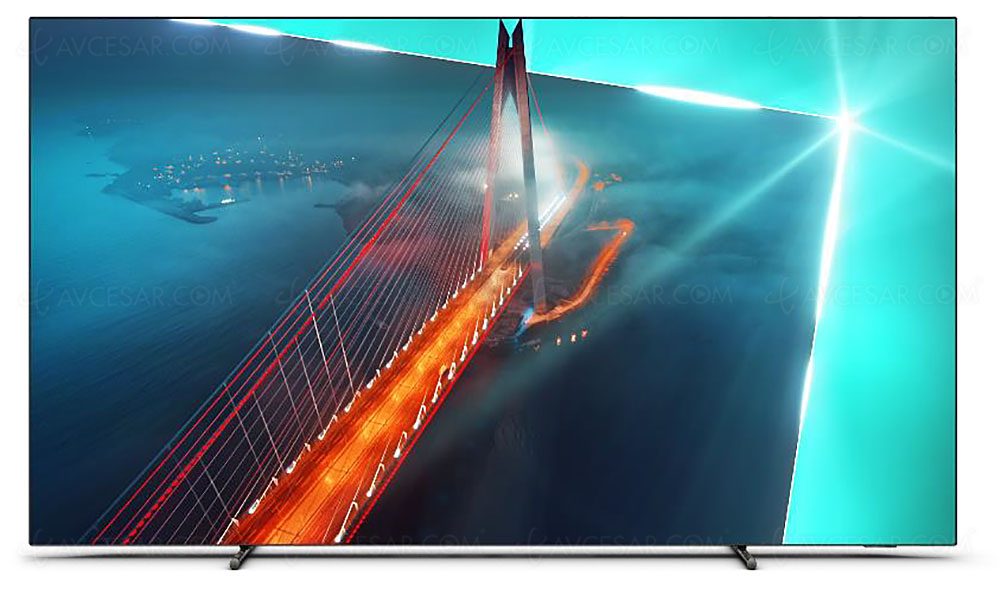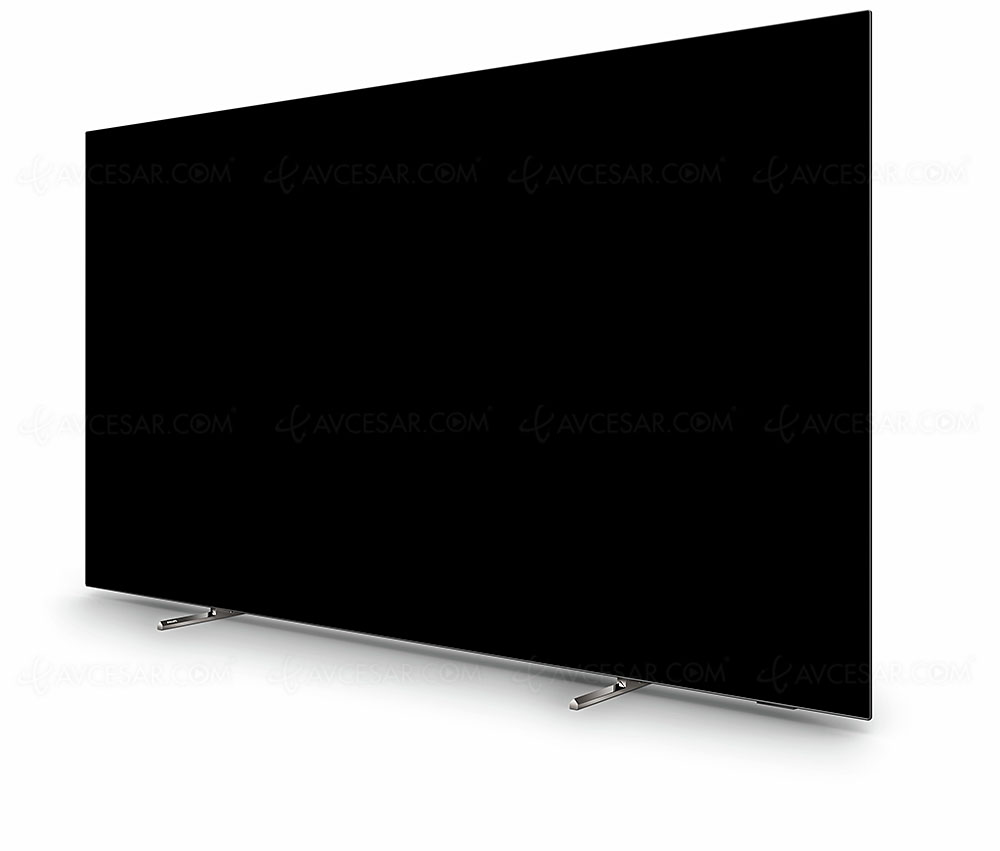Compared to the Philips OLED707 series marketed in 2021, the Philips OLED708 series will also have three references, the Philips 48OLED708 (48'', 122 cm), Philips 55OLED708 (55'', 140 cm) and Philips 65OLED708 (65 '', 165cm).

Philips OLED708 TV, the main developments
In short, the main differences between Philips OLED708 TVs and OLED707 TVs lie in the presence of the Smart Google TV 12 function instead of Android TV 11, a sound section revised downwards from a side because obedience 2.0 for a total power of 40 W (compared to 70 W and 2.1), but more ambitious on the other with DTS:X compatibility (compared to DTS-HD: precision, a Dolby Atmos decoder and a Dolby function Atmos Virtualizer are also required) and support for HDR Dolby Vision gaming up to 120 hertz.
TV Philips OLED708, P5 7th generation
For the rest, there is a "classic" Oled panel (and not Oled EX) displaying a peak light of 720 nits (10% white window), a three-sided Ambilight system (left, right and top) and a double leg instead of a central leg. Similarly, it is the P5 Gen7 chip that drives the OLED708 screens like the Philips OLED808 and Philips OLED908 series. Of course, the ambient light sensor and the anti-marking system (to counter the Burn-In phenomenon) are present. Plus an improved version of the Ambient Intelligence process designed to adjust the brightness, gamma and colorimetry adapted to ambient lighting in real time. This is based on a new light sensor that is much more precise to offer a white point that perfectly matches the lighting of the moment. Namely, the Super Resolution function, also improved, offers unprecedented sharpness and a great wealth of detail.

Philips OLED708 TV, connectors and connectivity
In terms of connectivity, there are still two HDMI 2.0 inputs and two HDMI 2.1 inputs with eARC, VRR (from 40 Hz to 120 Hz), HFR 4K/120, ALLM, HGiG, FreeSync Premium and G-Sync compatibility. The Input Lag is given by the brand at 16 ms with a 60 Hz signal, 8 ms at 120 Hz. There is also an optical output, two USB ports and a headphone output (independent volume). For connectivity, Wi-Fi ac and Bluetooth 5.0 are worth mentioning.
As expected, the Philips OLED708 TVs benefit from the DTS Play-Fi function allowing the configuration of a wireless 5.1 Home Cinema system or the integration of the TV into a multiroom system. Namely, Philips OLED708 TVs can be used as the center channel within a multi-channel setup.
HDR10+ Adaptive, HDR HLG and HDR Dolby Vision
Compatibility with HDR Dolby Vision, HDR HLG and HDR10+/HDR10+ Adaptive technologies is always active. And if the Google Assistant is integrated, we notice the “Works with Alexa†certification (need for an Amazon Echo Dot type speaker). Last point, the Philips OLED708 TVs have a DVB-T2 and DVB-S2 tuner.
Available. Indicative prices: €1,399 for the Philips 48OLED708, €1,599 for the Philips 55OLED708 and €1,999 for the Philips 65OLED708.
Update: the Philips OLED708 TV processor is indeed the P5 Gen7 and not Gen6 as initially announced. The news above has been corrected.
Reminder of the key characteristics of the Philips 48OLED708:
• 10-bit panel
• 100 Hz panel
• Oled panel
• Ultra HD/4K panel
• Processor: P5 Perfect Picture Engine Gen7 (AI)
• P5 Perfect Sharpness Ultra Resolution function
• P5 Perfect Contrast function
• P5 Perfect Color (WCG, Wide Color Gamut) function
• Ambilight + Hue function
• Perfect Natural Reality function
• VRR function
• eARC function
• ALLM (Auto Low Latency Mode) function
• 4K HFR 120 function
• HDR10 and HDR HLG compatibility
• HDR10+ compatibility
• HDR Dolby Vision compatibility
• HEVC compatibility
• Dolby Atmos compatibility
• Bluetooth 5.0 compatibility
• Wi-Fi ac Dual Band compatibility
• VP9 compatibility
• G-Sync compatibility
• DTS Play-Fi compatibility
• HDCP 2.3 compatibility
• HDR10+ Adaptive compatibility
• FreeSync Premium compatibility
• Dolby Vision 120 Hz Gaming HDR compatibility
• DTS:X certification
• Filmmaker Mode certification
• Outputs: 1 optical
• Inputs: 2 HDMI 2.1, 2 HDMI 2.0, 1 Composite, 2 USB ports (including one 3.0), 1 Ethernet port, 1 CI+ port
• Multimedia Google Assistant
• Multimedia Works with Alexa
• Google TV Multimedia
• Perfect Natural Motion Motion Compensation
• Input Lag: 16 ms with 60 Hz signal, 8 ms with 120 Hz signal
• Peak Brightness: 720 nits (white window 10%)
• DVB-T2 tuner
• DVB-S2 tuner
• Sound section: 2.0
• Power: 40 W
